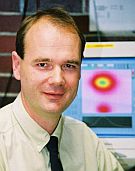Efimov State Observed
 Rudolf Grimm
Rudolf GrimmA Group of 10 Physicists led by Rudolf Grimm at the University of Innsbruck in Austria reported that they've been successful in converting three normal atoms into a special new state of matter called 'Efimov Quantum state' after the Russian scientist Vitali Efimov who proposed this in 1970. Efimov found a remarkable and counterintuitive solution to the notoriously difficult quantum-mechanical three-body problem, which concluded that 3 interacting particles can form a loosely bound system even if the 2-particle attraction is too weak to allow for the binding of a pair.
In order to prove that such a state can exist, experiments were conducted at Grimm's Laboratory on cesium atoms. There, for the first time, physicists were able to observe the Efimov state in a vacuum chamber at the ultra-cold temperature of a billionth of a degree above absolute zero, or minus 459.6 degrees Fahrenheit. Two of the three atoms repel one another in close proximity, but when you put three of them together, it turns out that they attract and form this new quantum state.
Efimov's result was a landmark in theoretical few-body physics, but until now these exotic states had not been demonstrated experimentally. Now that has been achieved, this may open up a new research specialty devoted to understanding the quantum mechanical behavior of just a few interacting particles.
The development is detailed in the March 16 issue of the journal Nature. If you are a Physicist, you may like to visit the website of Prof. Cheng Chin (University of Chicago) who is a member of the group that conducted this experiment.
Labels: Condensed Matter

0 Comments:
Post a Comment